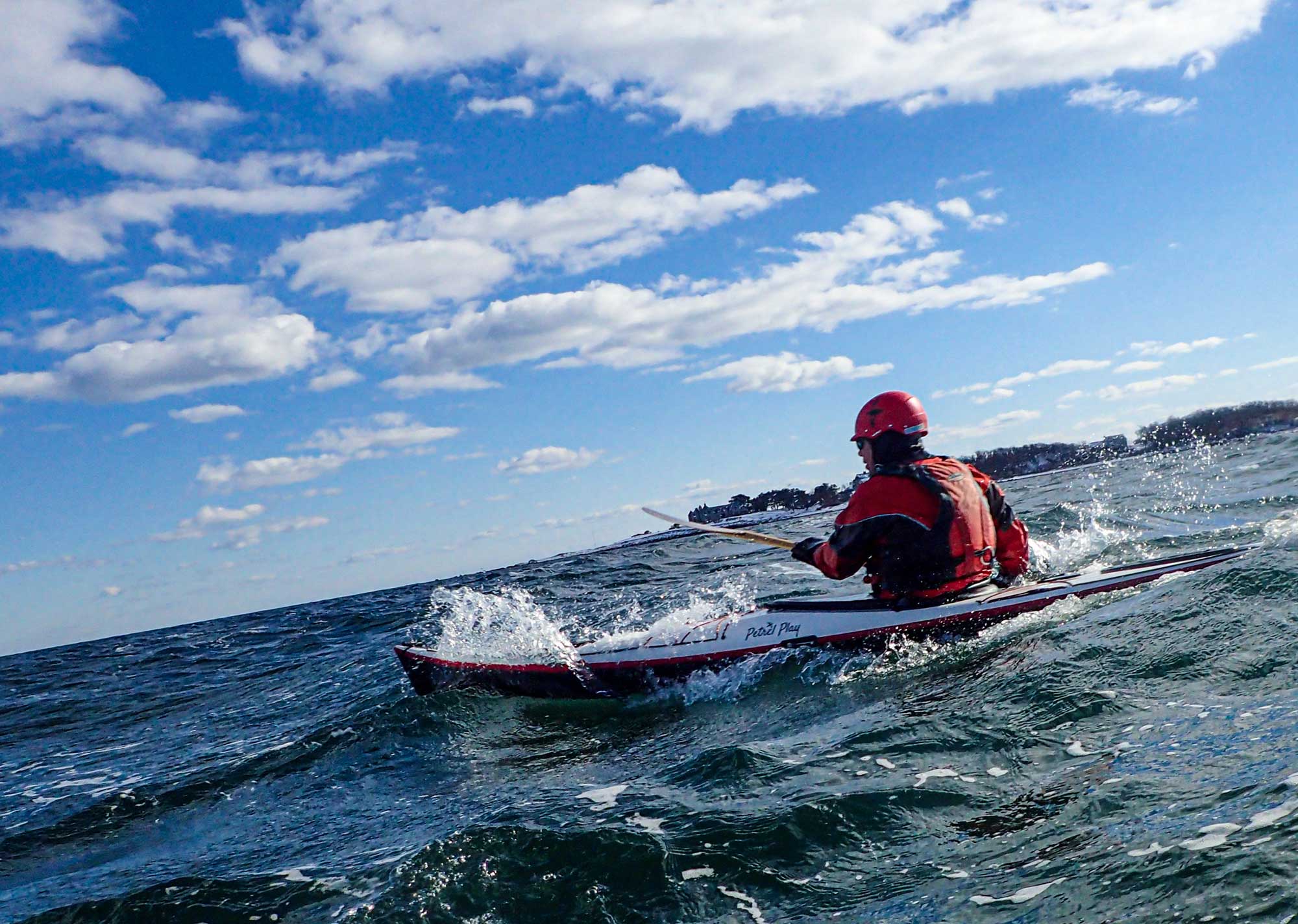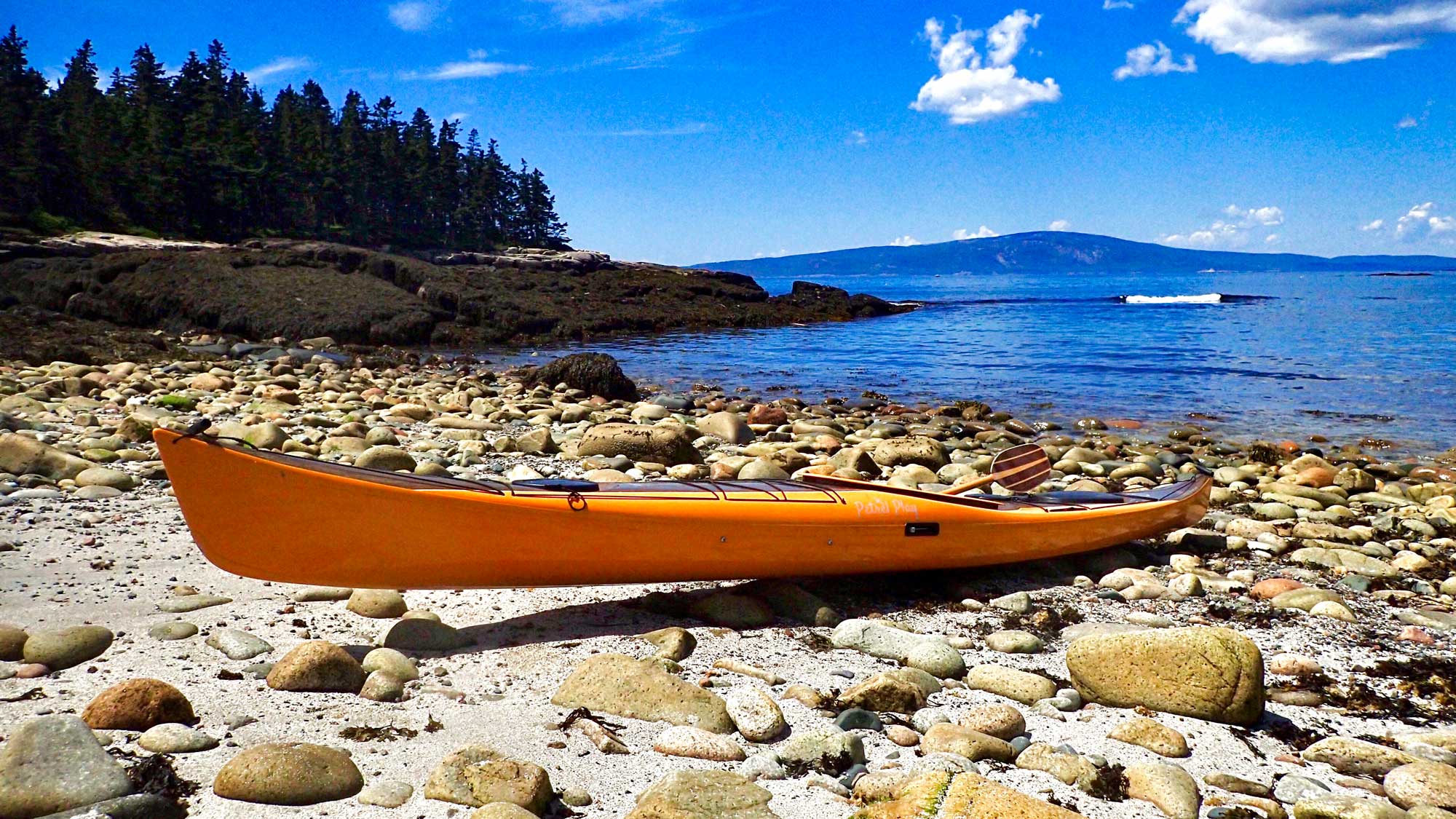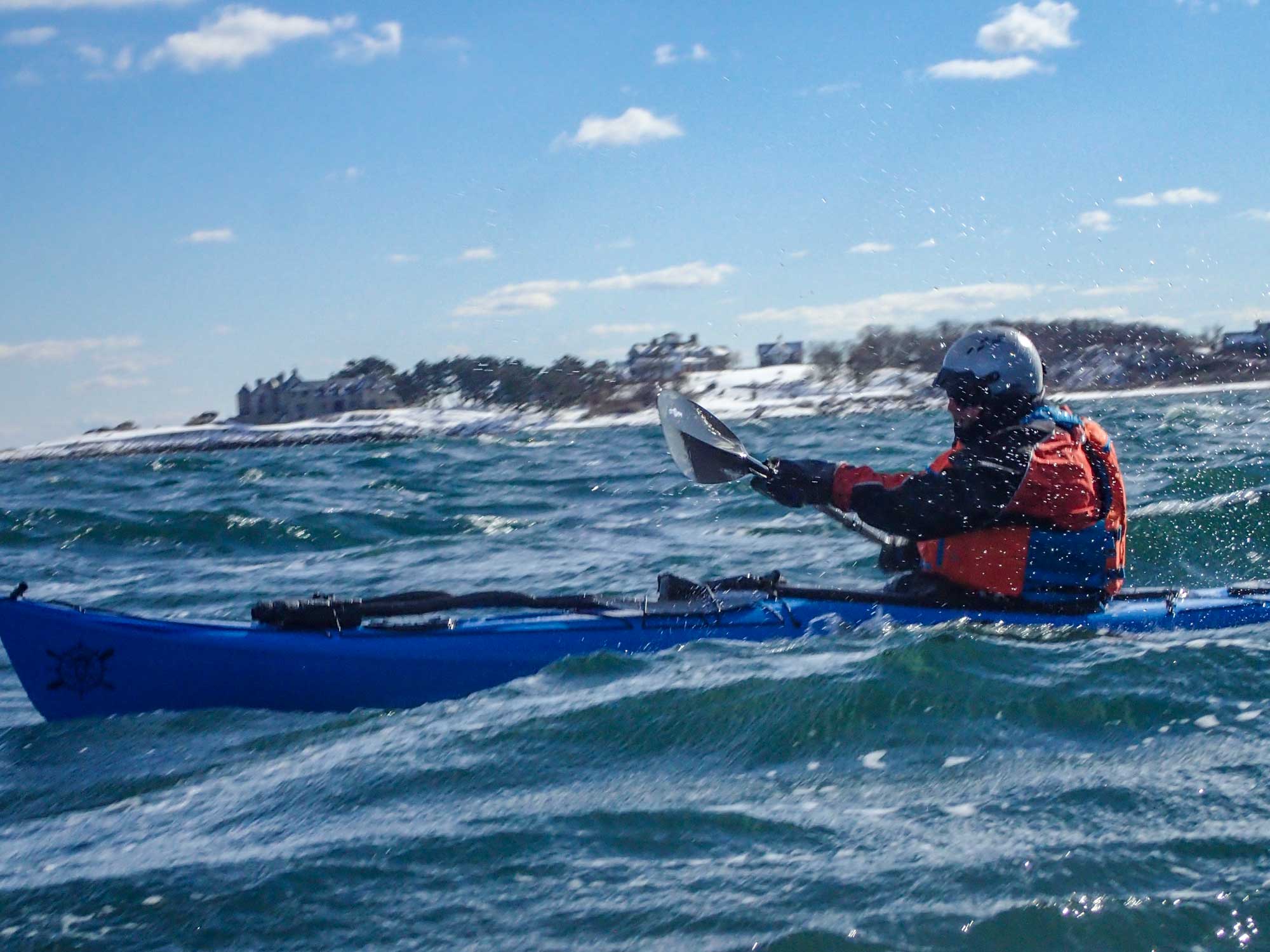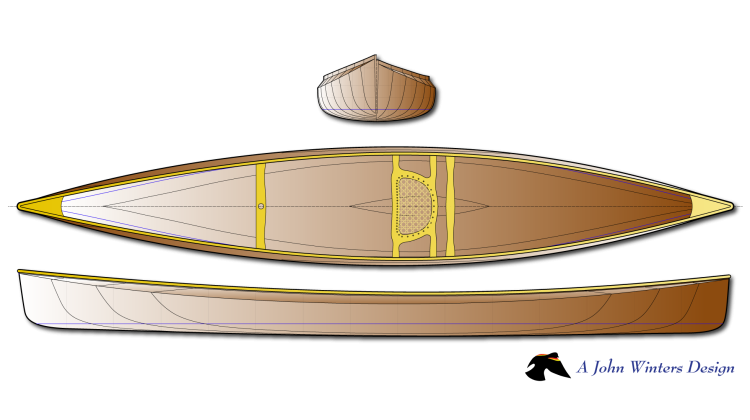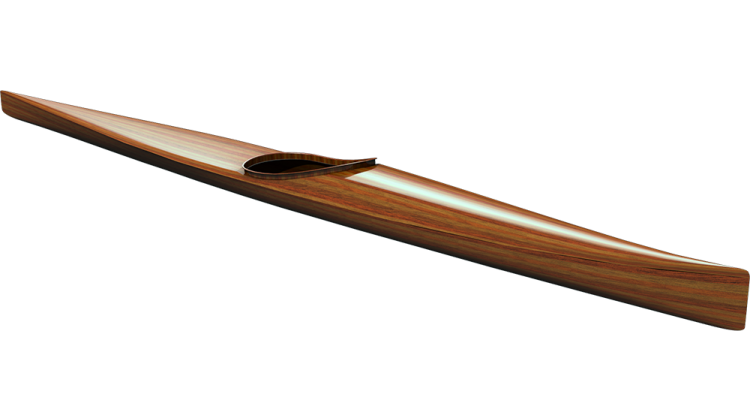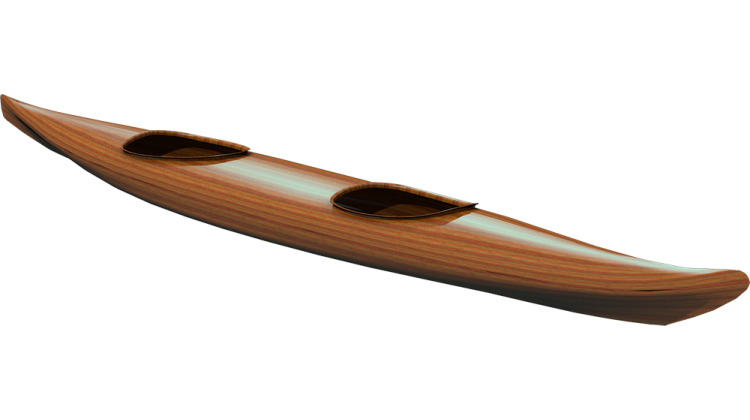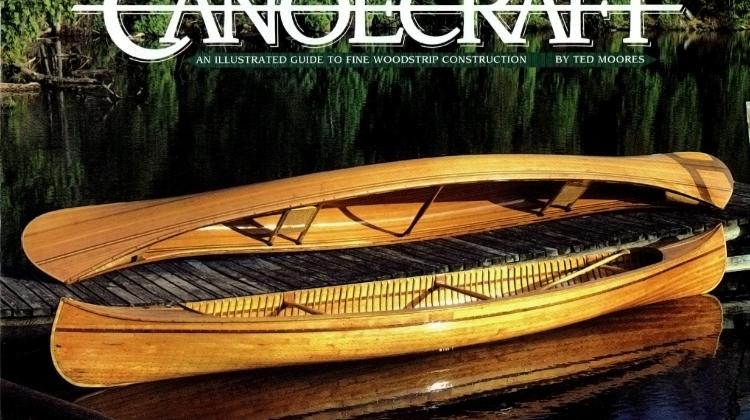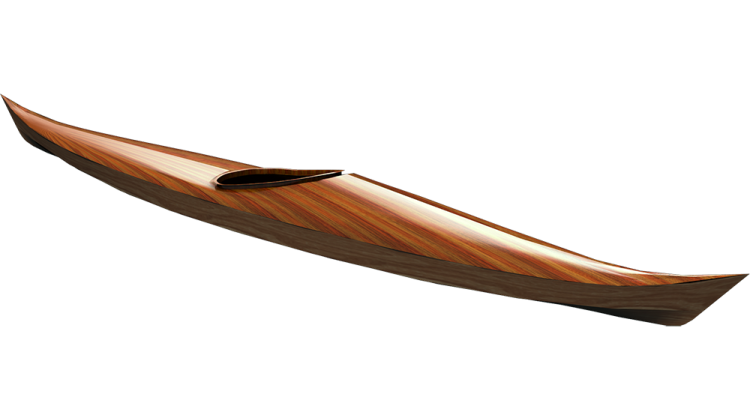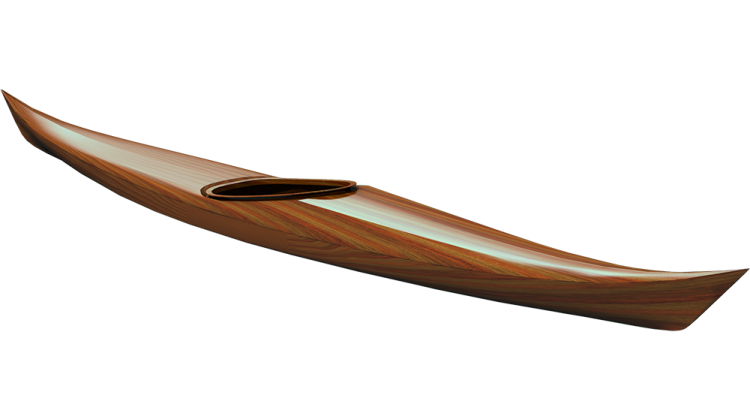People associate me with wood. I understand, they see me paddling wooden kayaks, the wood is the most obvious difference that draws people's attention and they assume that the wood part of the equation is what I'm interested in. But I make kayaks because I am interested in kayaks. I use wood to make my kayaks because it is a great means to getting the kayak I want. I paddle year around in New England in all kinds of conditions from glassing flat water to turbulent tide races and large shore breaks. I want a kayak that performs well in all the conditions I like to paddle.
Why I Build With Wood
The kayak needs to be strong. Getting tumbled end-over-end down the face of a hurricane wave puts some stress on a kayak. The kayak needs to be robust, bouncing of of boulders in a rock garden is bound to inflict some damage on a kayak, but I don't want it to put a premature end to the day. With all of that, the kayak still needs to be light weight. Every function of performance is improved as you make a kayak lighter. It will be faster, quicker to accelerate, and more responsive to what you maneuver it to do.
Wood provides this for me. While people often say "I would be afraid to put it in the water," the kayak can handle most of what the water can throw at it, what doesn't deal so well is people's emotions. They see a scratch on a shiny varnished wood surface and have trouble noticing anything else. Their attention is drawn by the blemish on the beauty. The kayak itself is really unchanged. A scratch doesn't nullify it as a kayak, it is just as good a kayak before and after the scratch. A scratch isn't a problem for the kayak, it is a problem for the human.
I make kayaks from wood because it allows me to make the kayak I want. I can start from a pile of wood strips and create a kayak that performs on the highest level on the water, and it happens to be beautiful. I don't think a scratch diminishes that beauty because part of the beauty is being out on the water. I would happily paddle a kayak made of ground up milk bottles if it performed the way I want.
I have long thought about creating composite versions of my designs. I made a plug and mold and vacuum bagged some of my kayaks in fiberglass and Kevlar back in the mid 1990s. I didn't go to far with it because I had a lot to learn about making boats in a mold, and got distracted by designing new and better kayaks. But the idea lingered. BTW, technically, my wood kayaks are composite kayaks in that they are covered with fiberglass or other reinforcing fabric. The wood just provides a structure to form the cloth around, but for the the purposes of this article "composite" will mean "glass or other fabric held together with some sort of resin".
While I am interested in composite kayaks, I still want a kayak that performs as well as my "wood" kayaks. I want lightweight, strong and robust. I don’t want the translation to composite to compromise the strength and durability of my wooden kayaks and I want the composite version to perform as well as the wooden kayaks, this means lightweight and responsive.
Well, duhh! Everyone knows that wood is heavy and weak while composites are light and strong. This translation should be a no-brained. Make a mold of the design, throw some fiberglass and resin into the mold and Shazam, you will have a kayak that is lighter and stronger than wood. Right? It is not that simple
Fiberglass Kayaks
Most composite kayaks are made in an open mold. The interior is shaped to match the exterior of the finished kayak. This means a female mold into which you lay your reinforcing fabric and some resin. This is a good way to make kayak, but it is important to note that resin is not strong, it is the reinforcing fabric that provides the strength. Usually this fabric is made from strands of fiberglass, but it could be anything: carbon fiber, Kevlar, or even hemp or cotton.
Regardless of what the fabric is made of, the fabric by itself is insufficient to turn it into a boat. Fabric is soft and floppy. When you think of glass, you generally think of window glass which is fairly stiff and pretty strong if a bit fragile to certain damage. You could probably imagine gluing sheets of window glass together into a boat shape and being fairly pleased with the results.
Fiberglass is made of tiny strands of glass pulled into long fibers. These fibers are thin enough that they bend easily and are quite hard to break. When woven into a fabric, you get a soft, pliable sheet that can be draped just like a bead sheet or table cloth. This not exactly what you would imagine to be good for making a strong boat.
When you glue all those thin strands of glass together so that they can’t slide past each other you can recreate something resembling the pane of window glass. It is rigid and stiff and quite strong. Unlike the window glass where one touch of damage in a single spot may propagate into a long crack or thousands of tiny chunks, a bit of damage to a strand of glass in the fabric doesn’t immediately spread into the rest of the composite sheet.
The composite sheet without the fiber is like a pane of window glass, resin by itself is prone to damage and once damaged, that damage will spread quickly and easily. It is the fabric in the resin that makes it strong. The higher the fiber content, the stronger it is.
As an aside: Wood is cellulose fiber held together with lignin glue. Wood is a naturally occurring composite material.
If you take a woven fabric, shape it into the form you want and then apply some sort of glue to hold it all together you can end up with a complex shape that is lightweight and strong. This is how kayaks and other fiberglass boats and high tech planes and vehicles are made. The tricky bit is, the composite is only strong in the directions the fibers run. If fibers run up and down but not left to right, if you bend the object in the left to right direction it will break.
This is typically solved weaving the fibers into a cloth with fibers running at 90 degrees to each other. In the above example the piece would become strong in the left-to-right bend. But there would be some weakness remaining to bends that are at an angle, or during a twist. The fancy word for this is that it is not “isotropic”. An isotropic layup has the same strength in all directions. The strength of a fiber reinforced layup is only in the direction of the fibers.
Another downside of a woven cloth is it doesn’t drape easily in all directions. Think of a table cloth at the corner of a table. You get folds. These folds appear because the yarns in the table cloth don’t stretch easily and the extra cloth needs to find a place to go as it hangs off the corner. Where along the edges the cloth just hangs, at the corners it bunches up and forms folds. If you want to get rid of the folds, you need to cut out the excess cloth around the corners
Complex kayak design shapes may have the equivalent of table corners where it is difficult to get the fabric to conform to the shape without creating tucks, folds and overlaps. Things like hatches, coamings, and deck fittings are spots on a kayak where the contours of the surface around which the cloth may have significant difficulty conforming. But even conforming to the bottom shape at the stem and stern can create issues laying up the cloth in smooth, even layers.
The process of developing any new product involves making decisions and potentially compromises based ease or difficulty of construction. Choosing a fabric that will conform to the shapes while being being strong and lightweight must be balanced with the labor required to make it. Labor is a major cost and influences every aspect of how the kayak is constructed.
Developing a Layup
In selecting a reinforcement layup for a kayak you must balance weight, strength and ease of building. We want as strong as possible, with as little weight as possible, and as easy as possible to build. As is often the case when optimizing three things, you are of left with the option of choosing two. You can have strong and easy to build, but it probably won’t be light, or you could have light and strong, but it probably won’t be easy.
Labor is a major cost in building a kayak, so essentially between the three options, Strong, Light and Cheap, you get to pick two. An example of this is a strip-built kayak. Sheathed wood construction is lightweight and strong, but it is labor intensive. So, while a DIY builder can get a nice kayak without spending a lot of money, they must put in a lot of labor. If you count your labor, building yourself a kayak is expensive.
While most reinforcing fabrics are woven in one form or another, there is another option. Chop strand mat (CSM) is kind of like felt. It is conglomeration of randomly oriented fibers held together with a soluble binder. The beauty of it is that it is isotropic (the fibers run in all directions) and it conforms to any shape. When you soak it with resin the binder holding the fibers dissolves allowing the material to nestle into and around complex shapes.
This is great labor savings over woven reinforcement fabrics. It allows the kayak maker to incorporate complex deck shapes and easily get reinforcement into deep contours such as the bow and stern of the hull.
The downside is it is heavy and weak. Because the fibers are randomly distributed and loosely bonded together, there is a lot of space between the fibers that must be filled with resin. Again, resin is not strong and in order to have enough strength, the resin ends up being quite thick. The result is inexpensive to make, but will not be lightweight if it is built strong.
Since the resin dissolves the binders holding together the mat, once resin is added the fibers are free to move. While useful for conforming to tricky shapes, unless the builder is quite skilled, the layup may have some spots that are thinner than other spots. If the builder is not careful, it is also easy for trapped air pockets to remain in the finished layup. While are is lightweight, it is not particularly strong.
CSM construction has been the industry standard for affordable composite sea kayaks for decades. Often times the hull is CSM with a layer of woven cloth on top, and the deck is primarily CSM sometimes with strategic woven cloth for localized reinforcement or cosmetic purposes. The boats have proven themselves as capable, but the quality control to produce consistent results. A design may vary in weight from one boat to the next. Likewise, the strength may be variable.
When choosing between, light, strong and cheap, these boats are centered on “cheap” and the needle swings between light and strong depending on who built them.
Higher end boats will use more woven fabric in the construction instead of CSM. While woven cloth is harder to layup smoothly and requires more effort to conform to complex shapes, a skilled builder can produce more consistent results by careful cutting and placement of the reinforcing cloth. By arranging the weave orientation within the layup they can get closer to an isotropic material where the strength is nearly the same in all directions.
Optimizing the Layup
In an open mold or “wet” layup the reinforcing fabric is carefully arranged in the mold and then resin is brushed and distributed into the cloth to saturate it and glue the fibers together so they maintain the shape after the resin has cured and the part is popped out of the mold. The resin fills all the gaps between the fibers, bonding to the fibers and holding them in place.
As noted before, fibers only reinforce in the direction they are running. In a woven cloth, the fibers rise and fall through the weave. They don’t flow in nice straight lines. Like tugging on a spring, the weave will stretch a bit when pulled. The resin limits the ability to straighten out, but the fiber will not demonstrate its full strength until it is pulled straight and tight.
As a result, a wet layup is not as strong as it could be given the strength of the fabric. The rise and fall of the yarns in the weaving pattern also creates gaps within the fabric that are filled with resin. Remember, resin isn’t very strong. Anything that is resin that could be fiber is adding weight without adding strength.
One way to overcome this is to compress the fabric. Squeezing the ups and downs of the weave in the fabric so the fibers are flatter and straighter creates a lighter layup that is also stronger.
This is where a vacuum bag comes into play. By placing the layup under a sealed plastic film and sucking the air out, earths atmospheric pressure compresses the fabric, straightening out the fibers and leaving less space between the yarns that need to be filled with resin. The result is lightweight and strong, but takes time and effort to get right.
Some manufactures will do a wet lay, then place the kayak in a bag, suck all the air out and compress the lay. Another option is to place all the dry fabric in the mold, cover the mold with a sealed bag, suck out all the air out and then use the resulting vacuum to pull resin into the layup.
Called the “Vacuum Assisted Resin Infusion Method” or “infusion” for short, this pre-compresses the cloth so only as much resin as necessary is used. Once the system is worked out, the results are very consistent, lightweight and strong.
Reinforcing Fabrics
There are a myriad of possible fabrics that could be used to make a composite kayak. The most common is fiberglass. Most composite kayak use fiberglass because it is strong, reliable and affordable. In the strong, light and cheap triangle, it hits everyone quite well, but there is room to improve on the strength and weight. Since weight is so important to the performance of a kayak, there is good reason to investigate how to keep the strength and reduce the weight.
The next two familiar fabrics are Carbon Fiber (CF) and Kevlar. Carbon fiber is known to be very light weight and super strong. Kevlar has many of same properties. Where CF and Kevlar differ is in toughness. CF tends to be brittle, like a pane of window glass, once CF starts to fail, it just breaks. Kevlar is not a resistant to bending, but it is tenacious stuff even if the resin around it fails, it will hold together. Instead of pieces breaking off the Kevlar will hold together.
Carbon fiber has historically been very expensive and at times virtually impossible to buy, but the prices have started to drop as it became more available. Kevlar is known for being lightweight and tough, but unfortunately resin have a hard time bonding to the aramid material and Kevlar is hydrophilic. It absorbs water over time. This obviously makes the layup a bit heavier and also reduces the strength.
There are new fibers being incorporated in composite layups. One of which is Innegra, a high modulus polypropylene that has similar properties to Kevlar, but bonds better with resins and does not absorb water. It can be used to with other fibers to make a tough, resilient layup.
Coatings
These fabrics and resins are often susceptible to damage from the sun and some sort of protection is required so they don’t degrade as they get exposed to UV radiation. This is the job of “gelcoat”. Gelcoat is a coating applied into the mold before the reinforcing fibers and resin are put in place. They differ from typical paints in that they are the first thing applied in a mold where materials like paint is applied to a nearly finished product. Paints and varnishes are “top coats” added near the end of the building process and “gel coats” are protective coatings added at the beginning of the building process. Paints get their shiny surface by curing to a smooth finish where gel coats get their shine a well polished mold.
The goal of either a gel-coat or a top-coat is to shield the resin and fabric from the sun. While they can provide a bit of protection from scratches and abrasion, that is not the purpose they are formulated to fill.
Some manufactures will apply a thick layer of gelcoat to provide and ablative layer that can absorb a lot of scratches and abrasion before you wear into the fabric. While this may prove effective, it adds significant weight and since standard gelcoat is actually just an unreinforced, pigmented resin, it provides no additional strength. A thick layer of gelcoat is brittle and susceptible to cracking. While these cracks are largely cosmetic, they do create a stress riser that will propagate more stress into the composite layup creating weak spots.
A builder can achieve better abrasion protection by applying additional layers of reinforcing cloth in high abrasion areas such as the keel line. By selectively protecting the high abrasion spots and using just enough gelcoat needed to provide UV protection, the builder can keep the weight down without losing any strength or durability.
Putting it All Together
Years ago Joey Schott was working at Chesapeake Light Craft, working to sell kits, building boats and dreaming of a business he could call his own. Like many builders, the idea of making wooden kayaks was a persistent fantasy that kept swimming around in his brain. He fell in love with my Petrel and Petrel Play designs. After looking at the sea kayak market, he saw there was room for a well built composite kayak.
While there were several builders concentrating on high quality fiberglass and carbon fiber kayaks, industry consolidation and inertia had created an opening for someone willing to innovate and push the envelope a bit.
He chose my Petrel Play as the first design he would bring to market with a high quality, modern composite layup. He would make a lightweight and strong sea kayak. The 14-foot long design is long enough to provide all the speed most kayakers need while be small enough to keep very lightweight and responsive.
I make kayaks because I love kayaking. I make them out of wood because, wood allows me to me to make a boat in my basement that meets all the performance needs I demand in a kayak. I want a high performance kayak. It needs to absorb abuse and keep on going. I want it quick and responsive. Playing out in large breaking waves with dynamic currents, I don’t want to fight my kayak. I want a kayak that provides a symbiotic extension of my body with which I can interact with the water. I have been able to make these boats for myself out of wood.
Until now, I have not found a composite boat that performs the way I want. They tend to be heavy, sluggish and insensitive to my input. I have seen a lot of well respected boat fail and break from what should be inconsequential impacts.
I am admittedly highly biased towards my designs. I design my kayaks for me as the primary client. I’ve spent decades learning how to make my designs perform to my requirements. I know how my kayaks work and my kayaks work the way I want them to perform. The Petrel Play made by Joey at Turning Point Boatworks is the composite version of what I think a kayak should be.
Joey use the vacuum infusion method to make a tightly packed layup of fiberglass, Innegra and other fabrics. They contain only as much resin as needed to make them strong and durable. Any more and they would become weaker and heavier. There is enough fabric in the layup to take hits that would shatter lesser builds and keep on running.
I have hull #2 that Joey has produced and as he was still refining his process, it came out “heavy” at just under 40 lbs [18kg], he is now producing some as light as 30-lbs [13.6kg]. By optimizing the fabric reinforcement and applying just enough UV protective coating to provide that needed protection, he is making refined kayaks tuned to do what they are designed to do without extraneous weight that would degrade the performance. The are light and strong.
The third variable in that equation is that they aren’t cheap. But, Joey is working at a small scale, keeping the overhead low, and keeping middlemen out of the price. He is creating an excellent value with a sub forty pound kayak that is suitable for quiet paddling or going out into rough water.
Not only does the light weight make the boat easy to lift off a car and carry down to the launch, but it accelerates quickly and cruise along effortlessly. The short length makes it easy to handle, it tracks straight but give it a slight edge it will turn on a dime. It is a great boat for a smaller paddler who doesn’t want to wrestle with a full sized sea kayak.
For an experienced paddler who wants to play in surf and tide races, the boat leaps to catch waves and catches the pocket with ease. On really fast runs the bottom will sometimes oil can, but generally feels very stiff as it rides over swell. Again, slight edging will carve a nice turn on a wave face. There is enough volume in the bow to keep from burying in most conditions. The width is sufficient to stay comfortably stable in chaotic water.
When I first started thinking about translating my designs to composite construction, I wanted it done while maintaining the high level of performance that I expect on kayaks I make for myself. Joey is meticulous in build standards, producing a smooth fair hull with flawless surface finish. The vacuum infusion layup is solid and stiff, it has a slight bell-like ring when you tap the surface, indicative of a tight fabric rich layup with a quality hard, strong resin.
I have inspected a lot well built kayaks over the years and the Turning Point layup is one of the best I have seen. I actually had the opportunity to do some destructive testing. While unstrapping it from the roof of my SUV on a windy day, the boat flew off the vehicle falling over 6 feet onto the asphalt parking lot. The seam tape between the deck and hull gave way, but other than some minor cosmetic cracks in the gel coat, the deck and the hull are completely intact. It will not be a hard repair with a roll of duct tape I could have gone paddling. A typical CSM constructed kayak would have turned into a loose bag of mush requiring major reconstructive surgery. There are few on-the-water situation which would put as much energy into the layup as that fall.
I am really impressed with the quality of Joey’s build and really feel that what he is doing is how all composite sea kayaks should be made. Quality construction translates into a fun and easy boat to paddle.
Check out the Petrel Play on the Turning Point website

